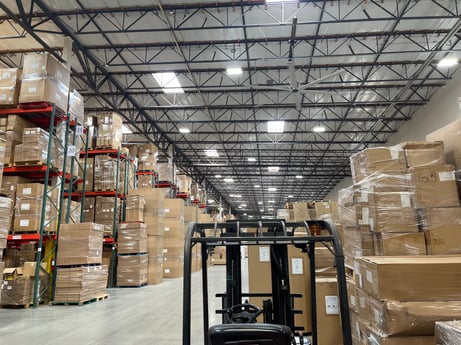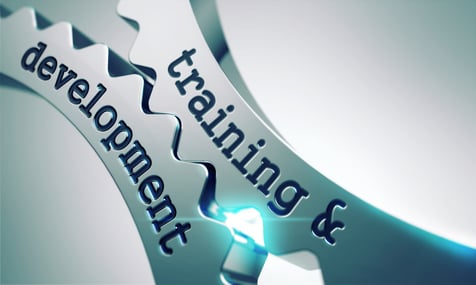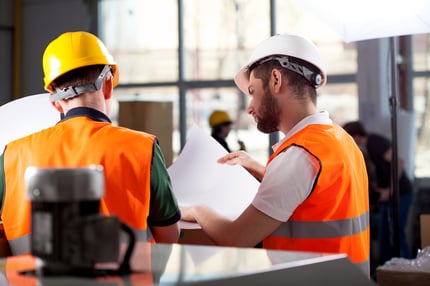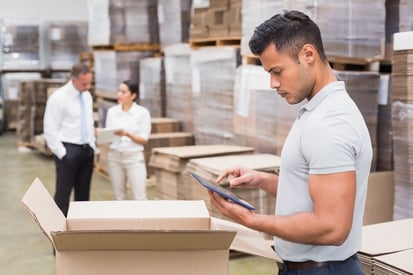Warehouse ventilation is an extremely important topic in today’s world. You take your health and...
10 Warehouse Safety Tips for Your Team

Warehouse safety is of the utmost importance for any warehouse manager. According to the US Department of Labor, 2.3 million dollars worth of penalties were issued to warehouse and storage facilities due to safety-related violations. Not only is it necessary to keep warehouse workers safe, but it is also crucial for maintaining a smooth-running warehouse operation. Accidents and injuries can cause delays and reduce productivity, leading to a negative impact on the bottom line. As a warehouse manager, it is your responsibility to ensure that your warehouse is a safe place to work. In this blog, we will provide a list of warehouse safety tips that you can use to keep your team safe while working.
Table of Contents:
- Protective Equipment
- Warehouse Floor
- Safety Protocols
- Regular Inspections
- Emergency Procedures
- Warehouse Staff Training
- Protective Clothing
- Forklift Safety
- Heavy Loads and Lifting
- Risk Assessments
Tip #1: Protective Equipment
Use protective equipment, such as safety goggles and gloves, to prevent injuries while working in the warehouse.

How to Implement:
-
Make sure that all warehouse workers are supplied with the appropriate protective equipment while on the job.
-
Encourage or require workers to wear necessary protective equipment at all times while working.
Why It Is Important:
-
Protective equipment is an essential part of creating a safe work environment in the warehouse. It helps to prevent injuries from occurring, such as eye injuries from flying debris or cuts from sharp objects.
-
Wearing protective equipment also helps to reduce the risk of musculoskeletal disorders, which can occur from repetitive tasks or lifting heavy objects.
-
By encouraging the use of protective equipment, you can help to reduce the risk of work-related injuries and improve employee morale.
Tip #2: Warehouse Floor
Keep the warehouse floor dry, clean, and clear of potential hazards, such as spills or obstructions.

How to Implement:
-
Regularly inspect the warehouse floor for spills or other hazards.
-
Add warehouse ceiling fans to prevent sweating slab syndrome.
-
Clean up spills immediately to prevent accidents from occurring.
-
Make sure that the warehouse floor is clear of clutter and obstructions.
Why It Is Important:
-
A cluttered or hazardous warehouse floor can increase the risk of accidents, such as slips, trips, and falls.
-
Keeping the warehouse floor clean and clear of obstructions helps to create a safe work environment for warehouse workers.
-
Adding ceiling fans will eliminate moisture on concrete floors keeping equipment and employees from slipping.
Tip #3: Safety Protocols
Implement safety protocols, such as hazard identification and reporting procedures, to help prevent accidents in the warehouse.
How to Implement:
-
Train warehouse workers on how to identify and report potential hazards.
-
Set up a system for reporting hazards, such as a designated person or a reporting form.
-
Regularly review and update safety protocols to ensure that they are effective.
Why It Is Important:
- Safety protocols are an important part of preventing accidents in the warehouse. By training warehouse workers on how to identify and report potential hazards, you can help to reduce the risk of accidents occurring.
- It is important to have a system in place for reporting hazards so that they can be addressed and corrected as soon as possible.
- Regularly reviewing and updating safety rules helps to ensure that they are effective in preventing accidents and maintaining a safe work environment.
Tip #4: Regular Inspections
Conduct regular inspections of the warehouse to identify and correct potential hazards.
How to Implement:
-
Schedule regular inspections of the warehouse, at least once per month.
-
During the inspection, look for potential hazards, such as damaged equipment or unsafe work practices.
-
Correct any hazards that are identified during the inspection.
Why It Is Important:
-
Regular inspections of the warehouse are an important part of maintaining a safe work environment. By identifying and correcting potential hazards, you can help to prevent accidents from occurring.
-
Regular inspections also help to ensure that equipment is in good working condition, which can help to reduce the risk of equipment failure and accidents.
-
By conducting regular inspections, you can help to identify and fix problems before they become serious issues.
Tip #5: Emergency Procedures
Have emergency procedures in place and train warehouse workers on how to respond in case of an emergency.
How to Implement:
-
Develop emergency procedures for common emergencies that may occur in the warehouse, such as fires or chemical spills.
-
Train warehouse workers on how to respond in case of an emergency, including where to go and what to do.
-
Make sure that emergency exits and equipment, such as fire extinguishers, are easily accessible and in good working condition.
Why It Is Important:
-
Emergencies can occur at any time, and it is important to be prepared. By having emergency procedures in place and training warehouse workers on how to respond, you can help to reduce the risk of injuries and damage in case of an emergency.
-
Having easily accessible emergency exits and equipment can help to ensure that warehouse workers can safely evacuate or respond to an emergency.
Tip #6: Warehouse Staff Training
Train warehouse workers on safe work practices and the proper use of equipment.
How to Implement:
-
Provide training on safe work practices, such as proper lifting techniques and the use of protective equipment.
-
Train warehouse workers on how to use equipment safely, including proper operation and maintenance.
-
Make sure that all warehouse workers are trained on emergency procedures.
Why It Is Important:
-
Training warehouse workers on safe work practices and the proper use of equipment is an important part of preventing accidents and injuries in the warehouse.
-
Proper training can help to reduce the risk of work-related injuries and improve employee morale.
-
It is also important to ensure that all warehouse workers are trained on emergency procedures so that they know how to respond in case of an emergency.
Tip #7: Protective Clothing
Provide warehouse workers with protective clothing, such as hard hats, safety vests, and steel-toed boots to prevent injuries.
How to Implement:
-
Supply warehouse workers with the appropriate protective clothing for their job tasks.
-
Encourage workers to wear protective clothing at all times while working.
Why It Is Important:
-
Protective clothing is an important part of creating a safe work environment in the warehouse. It helps to prevent injuries from occurring, such as head injuries from falling objects or foot injuries from heavy equipment.
-
Wearing protective clothing also helps to reduce the risk of musculoskeletal disorders, which can occur from repetitive tasks or lifting heavy objects.
Tip #8: Forklift Safety
Implement safety protocols and train forklift operators to prevent accidents or crush injuries while using forklifts in the warehouse.
How to Implement:
-
Train forklift operators on how to safely operate a forklift, including proper use of seatbelts and the importance of following safety protocols.
-
Establish safety protocols for the use of forklifts in the warehouse, such as designated areas for driving and speed limits.
-
Regularly inspect forklifts to ensure that they are in good working condition.
- Install mirrors at the ends of the aisles to prevent blind spots.
Why It Is Important:
-
Forklifts are a common piece of equipment in warehouses and can be a potential hazard if not used properly. By implementing safety protocols and training forklift operators, you can help to reduce the risk of accidents while using forklifts.
-
Regularly inspecting forklifts helps to ensure that they are in good working condition, which can help to prevent equipment failure and accidents.
Tip #9: Heavy Loads and Lifting
Improper lifting techniques are common causes of injuries in warehouses. Implement safe lifting practices and use mechanical aids, such as hoists or conveyor belts, to move heavy loads.
How to Implement:
-
Train warehouse workers on proper lifting techniques, such as keeping the load close to the body and using the legs to lift.
-
Use mechanical aids, such as hoists or conveyor belts, to move heavy loads whenever possible.
-
Make sure that warehouse workers have access to the appropriate equipment, such as dollies or hand trucks, to safely move heavy loads.
-
Implement pre-work stretching routines to help prevent injury due to heavy lifting.
Why It Is Important:
-
Lifting heavy loads can be a potential hazard in the warehouse and can lead to musculoskeletal disorders and other injuries. By implementing safe lifting practices and using mechanical aids, you can help to reduce the risk of injuries while moving heavy loads.
-
Providing warehouse workers with the appropriate equipment, such as dollies or hand trucks, can also help to make the task of moving heavy loads safer and easier.
-
Stretching can help to loosen muscles and prevent injuries due to heavy lifting.
Tip #10: Risk Assessments
Conduct risk assessments to identify potential hazards and implement controls to prevent accidents.
How to Implement:
-
Regularly conduct risk assessments of the warehouse and work tasks to identify potential hazards.
-
Implement controls, such as providing protective equipment or training workers on safe work practices, to prevent accidents from occurring.
-
Review and update risk assessments as necessary to ensure that they are effective in preventing accidents.
Why It Is Important:
-
Risk assessments are a crucial part of identifying potential hazards and implementing controls to prevent accidents in the warehouse. By regularly conducting risk assessments, you can help to identify and address potential hazards before they become serious issues.
-
Implementing controls, such as providing protective equipment or training workers on safe work practices, can help to reduce the risk of accidents and injuries in the warehouse.
-
It is important to review and update risk assessments regularly to ensure that they are effective in preventing accidents and maintaining a safe work environment.
Next Steps
As a warehouse manager, it is your responsibility to ensure that your warehouse is a safe place to work. By implementing the warehouse safety tips outlined in this blog, you can help to reduce the risk of accidents and injuries to your warehouse employees. To further aid in creating a safe work environment, we recommend downloading our warehouse safety checklist, which covers all of the important safety considerations for warehouse managers. By following these tips and regularly reviewing and updating your safety protocols, you can help to create a safe work environment for your warehouse staff and improve employee morale and retention.
Download your warehouse safety checklist now.
Learn more about the impact of warehouse accidents and how to prevent them by clicking the link below.










